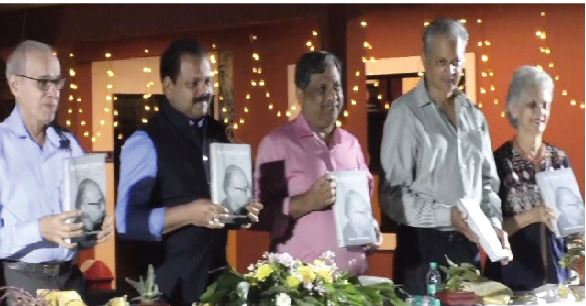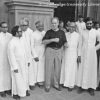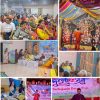Goa is abuzz with excitement as vintage bike and car owners, users, collectors and fans are decking […]

Legendary Doctors!ERNEST BORGES, A CANCER SURGEON TO REMEMBER!
Jan 28- Feb 03 2023 January 27, 2023Legendary Doctors!
AN EVENING OF REMEMBRANCE FOR DR ERNEST BORGES…at the International Centre Goa where some of Goa’s noted doctors of medicine collectively released Tata Memorial Hospital’s most famous cancer surgeon’s biography, titled `In Ernest Quest: EJ Borges, Legendary and Revered Cancer Surgeon’ written by daughter Renee Maria Borges. Say it is a daughter’s tribute to a much loved father! Amongst those doing the honours are (l to r) Dr Suresh Shetye, GMC dean Dr Shivanand Bandekar, Dr Shekar Salkar, Dr Afonso Bossuet, also family friend Padmashri Norma Alvares.
FEW in India and abroad too have not heard of the legendary cancer surgeon of Tata Memorial Hospital in Mumbai – Ernest J Borges. Both in Goa and Mumbai roads have been named after him with good reason. His biography “In Erest Quest, EJ Borges, Legendary and Revered Cancer Surgeon” written by his youngest daughter Renee Maria Borges and published by Cinnamonteal (a hardcover, Rs995) was released at the lovely lawns of the International Centre Goa on January 14, 2023 and it turned out to be most poignant, educative evening of remembrance. Not only family but medical fraternity remember the late Dr Ernest Borges with many warm memories. Quite simply, perhaps they don’t make exemplary medical folk like him anymore, only the older generation of doctors could set such a difficult example to follow!
Dr Ernest Borges was a pioneering oncologist at a time when there was no radiation or chemotherapy in the treatment of the big C or cancer and cancer patients were largely treated with surgery. Dr Borges was especially sought by patients suffering from throat or aesophaegal cancer – plus he was not only a fine surgeon, but a fine humanist, doctor, parent, friend and humourist and it is an irony that the good doctor himself passed away suffering from stomach cancer (which is a very painful cancer).
Shares
daughter and author of the biography, Renee Borges, “How he managed to lead a
normal family life while he was dying is a measure of his will and his
determination for us to have as many untroubled days as possible with him. This
was an act of great sacrifice and of great strength. Some of his family learnt
of his cancer only a month or so before his death; I knew only a few days
before; this was how good Ernest was at keeping up a pretence, even though he
was dying. Ernest passed away on the 3rd of March, 1969 , in Tata
Memorial Hospital. At that time, his oldest child Anita was 22 years old and a
medical student at Topiwala National Medical College and Nair Hospital, Bombay,
and his youngest child (me, Renee) was 10 years old and in the 5th Standard
at Canossa Convent, Mahim. Nina was in her First Year BA at St Xavier’s
College,
Rita was in the Intermediate Arts year at Sophia College, and Eric was in his
final year of the SSC (XIth Standard) at St Xavier’s High School. Grace was
widowed at the age of 51.”
Here is a
most unusually and lovingly researched biography of an iconic man of mainstream
medicine and the author has done a superlatively readable story. Clearly, Dr
Ernest Borges who worked at
Tata Memorial Hospital, Bombay, between 1941 and 1969, was not only a
remarkable student of medicine and oncologist surgeon extraordinary, but also a
man who loved to wear many habits in his lifetime – besides being a wonderful
father to his children, making time for them and never failing to take them for
annual holidays, something which made for memorable education for his family
and something they treasure along with memories of their distinguished father.
Renee Borges covered a gamut of pertinent subjects both personal and impersonal in her biography of her father; this is a rare biography both for students of medicine as also anyone who takes an interest in things to do with the medical world and healthcare as it has evolves and is evolving. Read it because you care about putting patients first as Dr Ernest Borges always did regardless of what background they come from and always humble enough to do the smallest thing himself instead of handing over the task to his juniors. His family too knew his role as a healer came first with him and accepted it.
The exhaustive biography covers all aspects of Dr Borges’ life and lifestyle as he chose to live it without fear and favour and there are chapters detailing close family members memories as several oral histories recounted to the author by key colleagues who worked with Dr Borges, namely Praful Desai, JN Suraiya, Gautam Sen, Vishnu Acharya, P Anantharam, Tehemton Udwadia, Manu Kothari, Sr AK Bhargavi, Bhaskar Kodange, Myrtle Duarte and these recounting does much to life the biography into a class of its own for it is meticulously recorded. The father in Dr Ernest Borges would be proud of a biography written by his loving youngest daughter after so many years had elapsed…in his lifetime he would never have entertained he idea of a biography, Renee Borges offered while speaking at the book release function, but perhaps he would forgive if he were still alive to see what a fair job she has done in putting so many aspects of his life together with painstaking planning and hard work!
The various chapters cover Dr Ernest Borges as father, husband, his professional networking, as an employee and administrator, his patients, the bulk of his medical research papers, his medico-moral thoughts, some interesting observations on the socialisation of healthcare as mirrored in the functioning of the National Health Service introduced in England in 1948, awards received (he was a Padmashri), there’s also easily understood information about cancer, also all the heart-warming eulogies and tributes which poured in after his death – perhaps no other doctor-surgeon has been so loved, admired and praised.
Dr Ernest Borges was a philanthropist in the best sense of the word and there is an Ernest’s Ark: The Dr Ernest Borges Memorial Home in Mumbai, the good doctor can certainly take a bow wherever he is in heaven today! This doctor, surgeon, scientist, researcher, humanist, philanthropist in material and spiritual sense, truly Christian…has left behind a very hard act to follow for anyone seeking to walk in his footsteps, even if they’re just fellow professionals or for that matter just patients who look towards and up to the medical fraternity to heal their troubled bodies and minds. Aren’t doctors still perceived as “mai-baap” by the many around the world, in the best sense of the words?
You want to read this biography especially in the light of an observation the good oncologist and surgeon Dr Afonso Bossuet made, while remembering the late Dr Ernest Borges…he said that he himself has observed that young doctors today hardly ever touch their patients, and perhaps like everything else in our world today, “medicine has gone cold!”
(Reviewed by Pankajbala R Patel)
(BOX)
Excerpted from `In Ernest Quest: EJ Borges, Legendary and Revered Cancer Surgeon’ by Renee Maria Borges….
My Memories of Ernest:
I have few personal recollections of Ernest as a doctor but the house was always filled with fruit and other goodies sent by grateful patients. In the mango season, one room was packed with baskets of mangoes spilling their straw, and the pink and blue candy-striped tissue paper in which the mangoes nestled would rustle delightfully. Ernest had some remarkable patients, such as Mrs Trilokekar (see pg188), who became friends of the family. Also remember a lovely old Koli woman in her nine-yard saree, and her blue eyes, and gorgeous heavy gold earrings that had weighed down her ear lobes. There was a wedding in her family at the Worli Koliwada village, and we were invited. It was so much fun to be part of another culture and to see Ernest being so comfortable with her family and all the guests. After the time spent convalescing from tuberculosis in Ahmednagar, he spoke Marathi like a native, and that could put people instantly at ease. I remember that Kishore Sahu, the film director who was a neighbour, once approached Ernest to play the role of a doctor in one of his films, perhaps Hare Kanch ki Chooriyan; we were in splits when it was suggested that Ernest rush in with an oxygen cylinder, and do all the dramatic life-saving things that doctors are supposed to do. Of course, Ernest declined the role, but it was a source of much private amusement for a long time.
Coming back to medicine, I remember that we had a built-in cabinet at home that, when opened, smelt of Elastoplast, gentian violet, iodine, and Threptin biscuits. Here was where Ernest kept his syringes and other minor equipment to tret home accidents and give first aid. Mouth ulcers were treted wih a cotton swab dipped in gentian violet which left one with a ghoulish smile. There were no drastic prescriptions such as regular purgatives, and I would recoil in horror when my school friends would tell me of their regular dosings of castor oil. I do remember the red-gold Adexolin capsules that we had to swallow with a glass of milk each morning to get our Vitamins A and D. We were allowed to eat just about anything, and Ernest himself relished street snacks such as boras and bhel puri. We sometimes went to restaurants, and the favourites were Kamling and Purohit at Churchgate and Fredricks at Dhanraj Mahal near the Regal Cinema, not far from the Gateway of India. Ernest was a spare eater but he enjoyed good food and loved to see his family happy and relaxed while dining out. He loved fried fish, rice and fish curry, or just plain sorak. We ate fish and beef every day while mutton, chicken and pork were for special occasions.
Earnest was able to transcend cultures and was equally at home singing and performing the mando, a traditional Luso-Goan dance that involved the whirling of handkerchiefs and singing romantic lyrics, as he was with classical ballroom dancing. He taught all my sisters to dance, and enjoyed a twirl around the dance floor, especially with Nina, who would wait eagerly for the New Year’s or Christmas Eve dances at the Catholic Gymkhana at Marine Lines. The mando was regularly performed at the annual meeting of the Ucassaim village (Ernest’s ancestral village in Goa) in Bombay, and even called the Ucassaim Social. Ernest and Gracie went to these Socials with the family in tow and he enjoyed meeting friends and relatives there. These Socials were usually held in school halls such as at St Theresa’s in Girgaum or at Victoria Church School Hall in Mahim. Since many people from Ucassaim lived in Girgaum, this area was mostly the focus of these events….
******************
Ernest is Revealed in Oral Histories:
Prafulla B Desai talks about his `guru’, who made him what he is today….
I had applied to Sloan Kettering (after the FRCS); at that time it was so easy. Paymaster just wrote a recommendation, and I put my papers together and because I had done a Registrar’s post at TMH, I easily got the offer at Sloan Kettering. But when I turned down the offer, I go a nasty letter from Sloan Kettering to the effect that never before had anyone turned down an offer at the Sloan. I wrote a letter of apology. That’s how I came back to TMH, and I never thought of anything else. The work was so overwhelming. And I learnt so much. We never felt the task was burdensome. We used to work until 9 in the night. Tara Hospital had traditions that made us proud. These traditions were instituted by the four people (Paymaster, Meher Homji, Borges and Jussawalla) who started it. At that time surgery was everything for cancer; there were very few other tools; radiation therapy and chemotherapy were just coming up.
(On the subject of Ernest’s cancer) We often ate together. So, one day I asked him, `Sir, What’s the matter; you are not eating too well; you re in a hurry. And you are working full speed, full blast. You are looking a little drawn; you have lost weight.’ `Yes,’ he said: `1This acidity is bothering me. And I take these antacids; it is all right. But because of the acid I don’t feel like eating.’ So, I said: `Why don’t we get some standard chest X-ray and other investigations done?’ he said: `No, I am going away with the family.’ He was going on holiday to Kashmir. `But when I come back, I will do it, 100% I will do it. But right now, when take I these antacids, it is all right. No problem.’ I couldn’t say more, but I insisted: `When you come back, you must do it.’ He said: `Just now I don’t want to do it.’ Whether he had already done it (the investigations), and didn’t want to tell me, I don’t know. He said: `As soon as I come back.’ Then he went away on holiday.
Once he came back from the holiday, he went to Dr Savur, in Matunga. He is a radiologist. He may have done it (an X-ray) before, but he never told anybody. Then one evening (by that time I had an office, and his office was a little away from mine), he just called up in the office. It was getting dark, around 7 o’clock, or 7.30. He asked: `Have you finished work?’ I said: `Yes, yes, sir.’ He said: `Just walk down to my office.’ So, I walked down to the office and he said: `I want you to see this X-ray.’ He put up his own X-ray, I mean…I did not know that it was his own X-ray. So, I looked at it; very typical of a problem in the stomach. A tumour in the stomach. So, I said: `This is pure cancer of the stomach. Whoever it is, needs surgery.’ It was interesting, actually. I thought he was showing it to me just for the sake of discussion. So, I said: `We need to go after it and get it out.’ So, he just smiled a little, a peculiar smile. And he said: `That’s my X-ray.’ I felt as if the earth was shaking loose, and I said: `You are joking. You must be joking.’ He said: “No, you remember that you were asking me why I was looking down, and I wanted to do this holiday. That’s my X-ray.’
It took me some time to gather myself, this coming from your own chief, and your own, what we call in India, your own guru. For a moment, you…it takes some time to gather yourself. So then in a quavering voice I said: `Sir, you must get admitted.” Now I could put everything together, why this was happening. And his haemoglobin was quite low, 7 or something. Because he was not eating. And he was pale. I said: `I think you need immediate admission. If you want, I will phone Gracie at home, and tell her that you are here. Or at least tomorrow morning, you come in, we will start your treatment. And I will speak to Dr Paymaster.’ He was the senior most person there. He said: `I’ll speak to Jal (Paymaster.’ `Sir, for you we can fly out tomorrow to New York, or Japan, there are some famous stomach gastric surgeons there. We can go to the best person in the world anywhere. Tomorrow we can phone up and go to New York, Sloan Kettering, or we can go to wherever. In less than 203 days we can go and get the best person to operate.’ But he said: `No, I want to have done on me exactly what I have done to others.’ He spoke in a very nice way: `Do unto others as you would want to have done unto you.’ That’s in the Bible and he said: `I don’t want to go anywhere; this is my hospital, I have worked here and you are closest to me; you know exactly how I work and I want only you to do it.’
Ernest Speaks as Surgeon and Physician:
What is Cancer and
What is its cause?
We all know that the body tissues are built up of microscopic units which are called cells. While normal cells of the body grow and function in an orderly fashion, the Cancer cell is a rebel, a revolutionary, and refused to conform. It grows and multiplies and forces its entry into other organs and tissues where it has no business to be – these are called Cancer deposits. The body is like a great city and the normal cells the millions of law-abiding citizens it contains. When a rebel group of cells begins its lawless activity various functions of the city are interfered with and the city may be paralysed – a sort of Bandha (sic) ensues. In the digestive tract, the rebels may affect food and nutrition; in the lungs supply of fuel; in the kidneys sanitation; in the blood communication and the police force; in the brain administration. IN this way cancer, the rebel may paralyse and destroy the whole body like the revolutionary destroys the Body Politic.
Now, what is it that makes a REBEL? The amazing thing about Cancer is that more is known about it than about any other disease. Yet no one knows exactly what it is. We do know of many factors associated with cancer. We know for instance that chronic irritation like a bad tooth may cause cancer of the tongue or cheek, that inhaling cigarette smoke may over the years cause a Cancer of the lung. But the precise process by which this rebel tendency is infused into the cell has not yet been discovered.
But there is a growing body of evidence that in any a Cancer, a virus may be involved. A virus is a living organism many times smaller than the germs we know about. It cannot be seen with the ordinary microscope and has only been visualized by the Electron Microscope. While it has been known for long that some cancers in animals are caused by viruses, the belief that some human cancers were also caused by viruses was first voiced in 1940 by a sensitive and fiery Spanish born scientist Dr Francisco Duran-Reynals of Yale University. His beliefs received scant support from other virologists. But just before his death in 1958 he had the satisfaction of having his view confirmed by a Nobel Prize Winner, Dr Wendell Stanley of California.
Now this idea that Cancer is caused by a Virus has immense possibilities and out of it is born hope for the cancer victim – for if Cancer IS caused by a virus we may soon discover a vaccine to immunize people against the virus of Cancer, in the same way as we now do for Smallpox and polio.
That there is such a thing as cancer immunity has been known to Cancerologists for many years. It is the only way we can explain scientifically the occasional case f spontaneous regression of Cancer recorded when a Cancer disappears or remains dormant for several years or even until the death of the patient from other causes….















